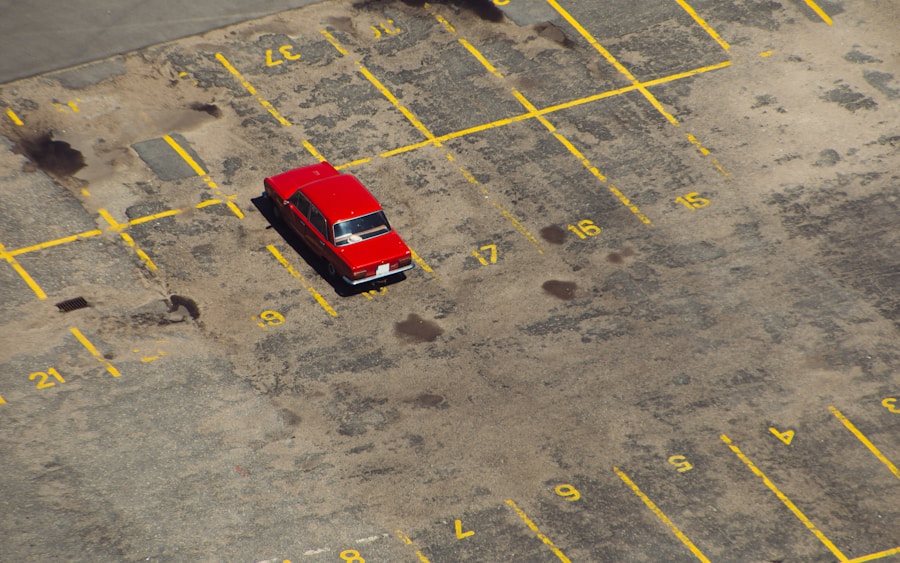A Pragmatic Guide to Parking Space Dimensions
When I think about parking space dimensions, I realize how crucial they are in the overall design of any parking lot. The standard dimensions for a typical parking space are often around 9 feet wide by 18 feet long, but these measurements can vary based on the type of vehicle and the specific needs of the facility. For instance, compact car spaces may be narrower, while spaces designated for larger vehicles, such as trucks or SUVs, require additional width and length.
Understanding these dimensions is essential not only for accommodating vehicles but also for ensuring that drivers can maneuver safely and efficiently. Moreover, the layout of parking spaces can significantly impact the flow of traffic within a parking lot. I have observed that angled parking spaces can facilitate easier entry and exit, while perpendicular spaces may maximize the number of vehicles that can fit in a given area.
The choice of dimensions and layout ultimately influences how users interact with the space, making it imperative to consider these factors during the design phase. By grasping the nuances of parking space dimensions, I can appreciate how they contribute to a well-functioning parking environment.
Key Takeaways
- Parking space dimensions are crucial for efficient and safe parking, with standard dimensions typically being 9 feet by 18 feet for a single space.
- Factors to consider in parking lot design include traffic flow, accessibility, and landscaping to create a functional and aesthetically pleasing space.
- Proper parking space dimensions are important for maximizing the number of spaces available and ensuring ease of use for drivers.
- Regulations and standards for parking space design vary by location, but generally include requirements for dimensions, accessibility, and signage.
- Working with a parking design company can help ensure that your parking lot meets all necessary regulations and is designed for maximum efficiency.
Factors to Consider in Parking Lot Design
As I delve deeper into parking lot design, I recognize that several factors must be taken into account to create an efficient and user-friendly space. One of the primary considerations is the anticipated volume of traffic. Understanding how many vehicles will use the lot at peak times helps determine the number of spaces needed and their arrangement.
Additionally, I must consider the types of vehicles that will frequent the lot, as this will influence the dimensions and layout of the spaces. Another critical factor is accessibility. I have learned that designing a parking lot with accessibility in mind is not just a legal requirement but also a moral obligation.
This means incorporating features such as wider spaces for individuals with disabilities, clear signage, and pathways that facilitate easy movement from the parking area to the building entrance. Furthermore, I must also think about safety measures, such as adequate lighting and visibility, to ensure that users feel secure while navigating the lot. By considering these factors holistically, I can contribute to creating a parking lot that meets the needs of all users.
Importance of Proper Parking Space Dimensions
The significance of proper parking space dimensions cannot be overstated. I have come to understand that inadequate dimensions can lead to a host of problems, including congestion, accidents, and frustrated drivers. When spaces are too narrow or too short, it becomes challenging for drivers to park their vehicles without encroaching on adjacent spaces or causing damage to their own cars.
This not only creates a negative experience for users but can also lead to costly repairs and liability issues for property owners. Additionally, proper dimensions play a vital role in maximizing the efficiency of a parking lot. When spaces are designed thoughtfully, they can accommodate more vehicles without compromising safety or accessibility.
I have seen firsthand how well-planned dimensions can lead to smoother traffic flow and reduced wait times for drivers looking for a spot. Ultimately, investing time and resources into determining appropriate parking space dimensions pays off in terms of user satisfaction and operational efficiency.
Regulations and Standards for Parking Space Design
Navigating the regulations and standards for parking space design is an essential aspect of my work in this field. Various local, state, and federal guidelines dictate how parking lots should be constructed to ensure safety and accessibility. For instance, the Americans with Disabilities Act (ADA) outlines specific requirements for accessible parking spaces, including their size, location, and signage.
Familiarizing myself with these regulations is crucial to avoid potential legal issues and ensure compliance. In addition to ADA guidelines, I must also consider zoning laws and building codes that may affect parking lot design. These regulations often dictate the minimum number of parking spaces required based on the type of facility or business being served.
I have learned that staying informed about these standards not only helps me create compliant designs but also enhances my credibility as a professional in this field. By adhering to regulations and standards, I can contribute to creating safe and functional parking environments.
Working with a Parking Design Company
Collaborating with a parking design company has been an enlightening experience for me. These specialized firms bring a wealth of knowledge and expertise to the table, which can significantly enhance the quality of a parking lot project. When I engage with a design company, I find that they often conduct thorough site assessments to understand the unique challenges and opportunities presented by the location.
This initial analysis is crucial in developing a tailored design that meets both functional and aesthetic needs. Moreover, working with professionals in this field allows me to tap into innovative design solutions that I may not have considered on my own. For instance, they may suggest incorporating technology such as smart parking systems or automated payment solutions that streamline the user experience.
I appreciate how these companies stay abreast of industry trends and advancements, ensuring that my project benefits from cutting-edge practices. Ultimately, partnering with a parking design company elevates my ability to create effective and modern parking solutions.
Maximizing Parking Space Efficiency
Maximizing parking space efficiency is a challenge that I often face in my work. One effective strategy I’ve discovered is implementing a well-thought-out layout that optimizes space usage while maintaining safety and accessibility. For example, using angled parking can increase the number of vehicles accommodated while allowing for easier access in and out of spaces.
Additionally, incorporating clear signage and markings helps guide drivers efficiently through the lot, reducing confusion and congestion. Another approach I’ve found valuable is utilizing technology to enhance efficiency. Smart parking systems can provide real-time information about available spaces, helping drivers locate spots quickly and reducing time spent circling the lot.
Furthermore, integrating payment solutions that allow for mobile payments or automated kiosks can streamline transactions and improve user satisfaction. By embracing innovative strategies and technologies, I can significantly enhance the efficiency of parking spaces while creating a more enjoyable experience for users.
Designing Accessible Parking Spaces
Designing accessible parking spaces is an area where I feel particularly passionate about making a difference. Ensuring that individuals with disabilities have equal access to facilities is not only a legal requirement but also an ethical responsibility. I have learned that accessible spaces must be wider than standard spaces—typically at least 8 feet wide—to accommodate wheelchair users and their vehicles comfortably.
Additionally, these spaces should be located close to building entrances to minimize travel distance. In my designs, I also prioritize clear signage indicating accessible spaces and pathways that are free from obstacles. It’s essential to create an environment where individuals with disabilities feel welcomed and supported.
Furthermore, I strive to incorporate features such as curb cuts and tactile paving to assist those with visual impairments. By focusing on accessibility in my designs, I contribute to fostering inclusivity within our communities.
Future Trends in Parking Space Design
As I look toward the future of parking space design, I am excited about emerging trends that promise to reshape how we think about these areas. One significant trend is the integration of electric vehicle (EV) charging stations into parking lots. With the growing popularity of electric cars, providing dedicated charging spaces is becoming increasingly important.
I envision future parking designs incorporating solar panels or other renewable energy sources to power these stations sustainably.
Another trend gaining traction is the concept of multi-use spaces that serve various functions beyond just parking vehicles.
For instance, some designs are incorporating green spaces or community areas within parking lots to enhance aesthetics and promote social interaction.
This shift towards multifunctional designs reflects a broader movement toward sustainability and community engagement in urban planning. In conclusion, my journey through understanding parking space dimensions has revealed their critical role in creating functional and efficient environments. By considering various factors in design, adhering to regulations, collaborating with experts, maximizing efficiency, prioritizing accessibility, and embracing future trends, I am committed to contributing positively to this essential aspect of urban infrastructure.
FAQs
What are the standard dimensions for a parking space?
The standard dimensions for a parking space are typically 9 feet wide by 18 feet long. However, these dimensions can vary depending on local regulations and specific requirements for different types of parking spaces.
What are the dimensions for accessible parking spaces?
Accessible parking spaces are typically 8 feet wide and have an adjacent access aisle that is at least 5 feet wide. The access aisle is designed to provide space for wheelchair users to enter and exit their vehicles.
What are the dimensions for compact car parking spaces?
Compact car parking spaces are typically 8 feet wide by 16 feet long. These spaces are designed to accommodate smaller vehicles and are often found in parking garages or lots with limited space.
What are the dimensions for motorcycle parking spaces?
Motorcycle parking spaces are typically 5 feet wide by 9 feet long. These spaces are designed to provide designated parking for motorcycles and other two-wheeled vehicles.
What are the dimensions for parallel parking spaces?
Parallel parking spaces can vary in size, but a typical standard size is 8 feet wide by 22 feet long. These spaces are designed for vehicles to park parallel to the curb and are commonly found on city streets.
Sources:
- U.S. DOJ – ADA Standards for Accessible Design (2010)
- ITE – Parking Generation Manual, 5th Edition
- NACTO – Urban Street Design Guide
- FHWA – Parking Facility Design Guidelines
- U.S. Department of Energy – EV Infrastructure Strategy 2023
- McKinsey – The Future of Parking and Urban Design, 2023
- IPMI – Professional Design Services for Parking Facilities

